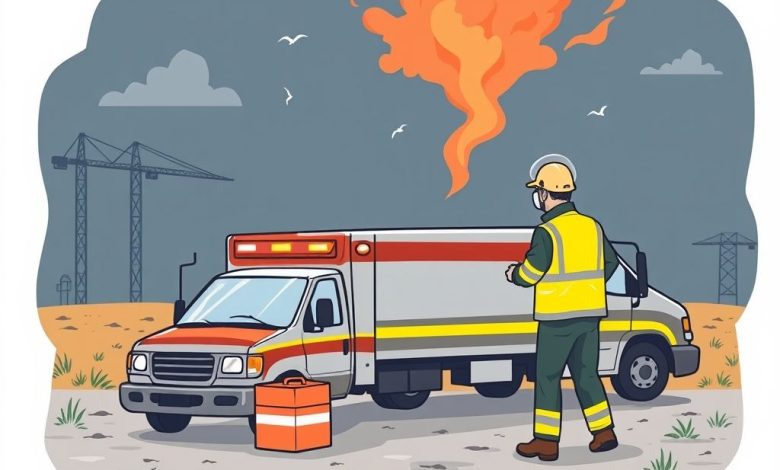Field Service Management for Emergency Evacuation Equipment Optimizing Response and Efficiency

Field Service Management for Emergency Evacuation Equipment
Introduction
Field Service Management (FSM) plays a crucial role in ensuring the efficient operation and maintenance of emergency evacuation equipment. These systems are critical during natural disasters, building emergencies, and other crisis situations where quick evacuation is necessary. In this article, we will explore the importance of FSM in managing emergency evacuation equipment, its key components, best practices, and challenges faced by field service managers.
Importance of FSM in Emergency Evacuation Equipment
Emergency evacuation equipment such as elevators, escalators, fire alarms, and sprinkler systems are essential for public safety. However, their proper functioning depends on regular maintenance and timely repairs. Field Service Management software helps streamline these processes, ensuring that equipment is always ready to perform when needed.
Key benefits of FSM for emergency evacuation equipment include:
- Improved response times
- Enhanced safety measures
- Reduced downtime
- Cost-effective maintenance
- Better resource allocation
By implementing FSM, organizations can ensure that their emergency evacuation equipment is consistently maintained and repaired, reducing the risk of failures during critical situations.
Key Components of FSM for Emergency Evacuation Equipment
A robust FSM system typically includes several modules that work together to manage emergency evacuation equipment effectively. Some of the main components include:
- Work Order Management
- Creation and assignment of work orders
- Tracking of equipment status
- Prioritization of tasks based on urgency
2. Inventory Management
- Tracking of spare parts and consumables
- Automatic reordering of supplies
- Optimization of inventory levels
3. Scheduling and Dispatch
- Efficient scheduling of technicians
- Route optimization for multiple service calls
- Real-time tracking of technician locations
4. Customer Relationship Management (CRM)
- Maintenance history of equipment
- Communication with customers
- Feedback collection and analysis
5. Reporting and Analytics
- Performance metrics and KPIs
- Equipment utilization rates
- Identification of trends and patterns
These components work in conjunction to provide a comprehensive solution for managing emergency evacuation equipment through FSM.
Best Practices for Implementing FSM in Emergency Evacuation Equipment
To maximize the effectiveness of FSM for emergency evacuation equipment, field service managers should consider the following best practices:
- Standardize Work Procedures
Develop clear, standardized procedures for all types of maintenance and repair tasks. This ensures consistency across all technicians and improves efficiency. - Invest in Proper Training
Provide thorough training to technicians on the specific emergency evacuation equipment being managed. This includes knowledge of operational principles, common issues, and troubleshooting techniques. - Regular Equipment Inspections
Implement a systematic inspection schedule for all emergency evacuation equipment. This proactive approach helps identify potential issues before they become major problems. - Utilize Mobile Technology
Leverage mobile apps and tablets to enable technicians to access work orders, check inventory, and update statuses directly from the field. This improves real-time communication and reduces paperwork. - Implement Preventive Maintenance
Develop and execute preventive maintenance schedules tailored to each type of emergency evacuation equipment. This proactively addresses potential issues before they occur. - Maintain Accurate Records
Ensure all maintenance activities, including completed work orders and inventory transactions, are accurately recorded. This data is crucial for future planning and decision-making. - Conduct Regular Audits
Perform periodic audits of the FSM system to ensure it is functioning optimally. Identify areas for improvement and gather feedback from technicians and customers. - Stay Updated with Regulations
Keep abreast of changing regulations and industry standards related to emergency evacuation equipment. Ensure the FSM system complies with current requirements. - Foster Collaboration
Encourage open communication between different departments involved in emergency evacuation equipment management, such as operations, maintenance, and facilities. - Continuously Improve
Regularly review and refine the FSM process based on performance metrics and customer feedback. Look for opportunities to enhance efficiency and improve overall service quality.
By adhering to these best practices, field service managers can optimize the use of FSM for emergency evacuation equipment, leading to improved safety, reduced costs, and enhanced customer satisfaction.
Challenges Faced by Field Service Managers
Despite the numerous benefits of FSM for emergency evacuation equipment, field service managers often face several challenges:
- Technological Complexity
The integration of various technologies within FSM systems can be complex, requiring significant investment in training and support. - Data Security Concerns
Handling sensitive information about emergency evacuation equipment and maintenance activities necessitates robust security measures to protect against cyber threats. - Balancing Efficiency and Safety
There’s often a trade-off between completing jobs quickly and ensuring thorough, safe execution of maintenance tasks. - Managing Remote Locations
Servicing emergency evacuation equipment in remote or hard-to-reach locations can pose logistical challenges and increase travel time. - Adapting to Changing Regulations
Keeping up with evolving regulations and standards related to emergency evacuation equipment requires continuous effort and resources. - Managing Multiple Types of Equipment
Different types of emergency evacuation equipment may require specialized skills and knowledge, making it challenging to standardize processes across all assets. - Dealing with Urgent Requests
Responding promptly to urgent maintenance requests while maintaining scheduled services can be stressful and demanding on resources. - Ensuring Technician Competency
Maintaining high-quality technicians who are skilled in handling various types of emergency evacuation equipment is crucial but can be challenging, especially in competitive job markets.
Addressing these challenges requires ongoing innovation, strategic planning, and a commitment to continuous improvement in FSM practices for emergency evacuation equipment.
Conclusion
Field Service Management is a vital component in ensuring the optimal functioning of emergency evacuation equipment. By leveraging advanced technology and best practices, field service managers can significantly improve response times, reduce equipment downtime, and enhance overall safety measures.
As technology continues to evolve, FSM systems will likely incorporate more AI-driven predictive maintenance capabilities, augmented reality for remote diagnostics, and blockchain for secure data storage. These advancements will further streamline operations and improve the reliability of emergency evacuation equipment.
For field service managers responsible for emergency evacuation equipment, staying ahead of these technological developments and adapting to changing regulatory landscapes will be crucial. By doing so, they can continue to deliver exceptional service while ensuring the highest level of safety for individuals relying on these critical systems during emergencies.
Ultimately, the goal of FSM in emergency evacuation equipment management is not just to maintain equipment but to save lives and property. As the field continues to grow and evolve, the importance of effective FSM cannot be overstated in the context of disaster preparedness and response.




